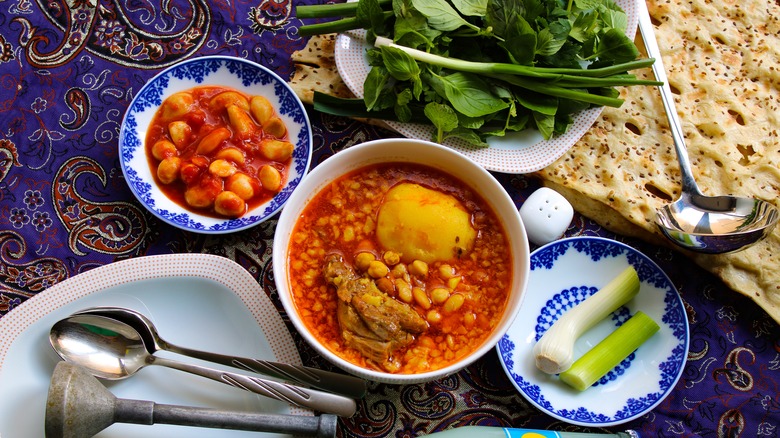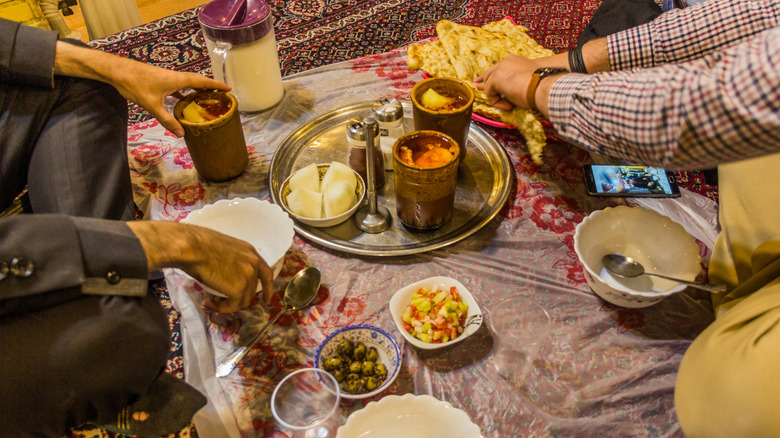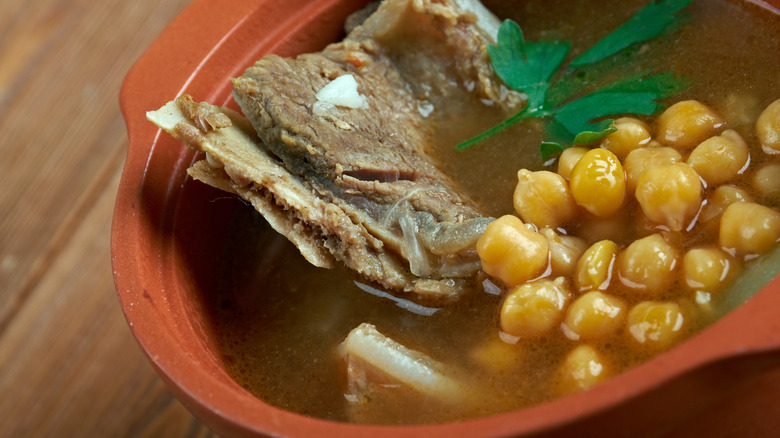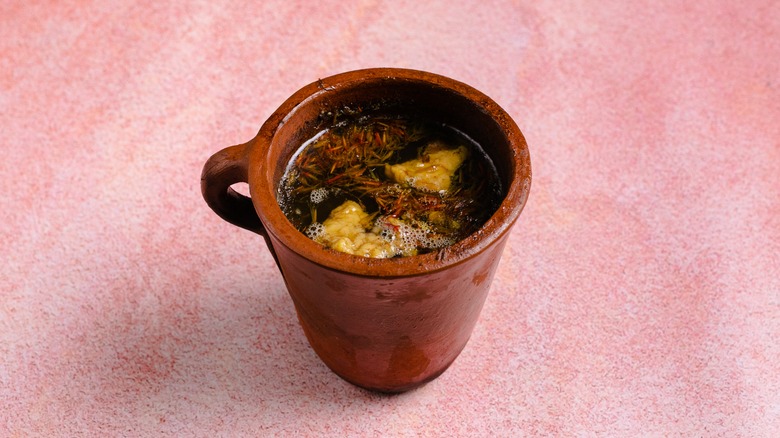Abgoosht: The Ancient Iranian Stew Featuring Lamb And Dried Limes
There's something special about finger food. Whether it's tasty small appetizers served during a sports event or a full bulgogi feast wrapped in lettuce leaves, eating sans utensils adds a casual, convivial touch. As Emily Johnson notes for Epicurious, chowing down on tacos, pizza, and burgers with fingers is seldom a faux pas in the U.S. Yet, expanded to other entrees, social expectations become blurred. Worldwide, many cultures embrace forkless feasting — in areas of the Middle East, Africa, South Asia, and South America, it's widespread, per Condé Nast Traveler.
In Iran, a finger food favorite is abgoosht, a stew made with lamb and chickpeas. After cooking, the dish is separated into two components — hearty meat and chickpea mash and the broth used for cooking. It's served alongside flatbread, herbs, and pickles. According to New York Time Cooking, some pieces of bread are torn up into the broth, and others are turned into small sandwiches with garnishes. The experience is immersive yet casual, an ideal candidate for a Sunday night meal.
What is abgoosht?
A hearty stew, abgoosht is a cornerstone of Persian cuisine. Its two fundamental ingredients are lamb and chickpeas — other fruits, vegetables, and spices are added based on the season and chef's preference, per Cook's Illustrated. The name translates to its principal essence — ab means water, while goosht means meat. Consumed with a large spread of accompaniments, the stew unites families, friends, and neighbors, via "A Treasury of Persian Cuisine."
First noted in 14th-century Persian poetry, abgoosht has maintained a time-honored preparation for centuries. Traditionally prepared in a dizi, a large clay pot, the dish can be left unattended fireside until completion. Typically prepared by women, the ingredients are combined in a low-heated vessel and left to simmer until midday. Then, the family assembles for a hearty lunch. Served in one communal bowl, it's eaten by hand using flatbread. Abgoosht can be a quotidian lunch for workers or embellished for special occasions — the stew transcends social classes, notes Encyclopaedia Iranica.
How is abgoosht prepared?
Abgoosht starts with a bone-in cut of lamb like a shank, satiated with fat and collagen to thicken the stew, per Cook's Illustrated. The meat is covered with water and slow-cooked alongside additions like onions, tomatoes, soaked chickpeas or beans, potatoes, spices, and most notably, dried limes — which add a sour, slightly funky flavor. The dish's most fundamental attribute is how it's served. After the meat tenderizes off of the bone, the broth is sieved from the solids. Then the meat and vegetable mixture is mashed, either by the chef or with individual mortar and pestles. Such a process homogenously spreads the flavors.
Abgoosht is served with a large variety of accompaniments — an abundance of herbs, sliced radishes, cheese, and the one constant, flatbread. Diners pick from the spread of ingredients to make individual sandwiches with solid mash. The broth is consumed from a bowl, usually thickened with bread, per The Caspian Chef.
Abgoosht variations
With unique renditions across the Middle East, abgoosht is a versatile dish open to interpretation. In Armenian and Assyrian cuisine, it's made with beef rather than lamb, via MasterClass. The vegetable base is frequently altered in Iran, utilizing beans, okra, eggplant, potatoes, and herbs, instead of chickpeas. These substituted versions are closely related to bozbash, an Azerbaijani dish in which the lamb is not mashed, but the spice and vegetable base are similar, via Taste Atlas.
Although lamb is a traditional cornerstone, abgoosht can be reimagined as a vegetarian or even vegan dish. Taste Crescent recommends upping the number of beans, including other root vegetables, and adding mushroom broth for an umami-boosted vegan rendition. Alternatively, a low-carb version can be made without beans entirely, utilizing eggplant and okra.
The experience of feasting on abgoosht and its numerous condiments fork-free makes for a convivial meal. However, for a more straightforward weeknight meal, strive for its essence — a mashed, nutritious, one-pot stew.



